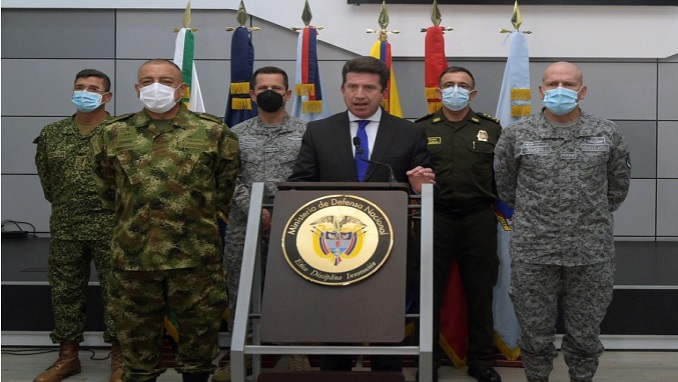Colombia’s armed forces eliminated 13 rebels from the Revolutionary Armed Forces of Colombia (FARC) guerrilla group in a bombing attack in the country’s south, Defense Minister Diego Molano said on Wednesday as quoted by Sputnik.
“No truce to drug criminals who steal the peace of Colombians. The bombing attack by our Colombian armed forces, supported by the prosecutor’s office in Calamar, Guaviare, neutralized 13 members of FARC’s Gentil Duarte team,” Molano wrote on Twitter.
According to Molano, the killed drug traffickers recruited minors, staged attacks on security forces, kidnapped people, and also engaged in illegal extraction of mineral resources. Molano did not say when the assault happened.
“These narco-criminals are responsible for the recruitment of minors, attacks against our public forces, kidnapping and illegal mining,” said Molano.
He added the government will “not rest” until it finds Duarte, one of the most wanted rebel commanders in Colombia. A source told AFP 10 died and three were wounded. These dissidents have distanced themselves from Colombia’s 2016 peace pact, which ended a half-century civil war and saw the FARC disarm the following year.
The bombing was conducted in the municipal area of Calamar in the jungle of northern Colombia, where former FARC dissidents still operate.
Last Friday, the country launched a 7,000-strong elite force to fight rebels financed by drug trafficking and other illegal activities. It said the force would pursue members of the ELN — the last active guerrilla group in Colombia — as well as drug gangs and ex-FARC rebels who have abandoned the peace terms.
In December, the UN said the Colombian government had killed 244 former FARC fighters since the signing of the peace accords. In February, a former FARC leader, Seuxis Pausias Hernandez Solarte, aka Jesus Santrich, threatened Colombian President Ivan Duque with death in a video that was broadcast by a local TV channel.
FARC was founded in 1964 as a military wing of a local communist party. It was supposed to fight for the creation of a “New Colombia”, which was meant to be a society of social justice and equality. FARC numbered up to 20,000 fighters back then.
Meanwhile, according to Colombia Reports, Colombia’s war crimes tribunal ordered the government to take urgent measures to curb the mass killing of demobilized FARC guerrillas. In a press release, the Special Jurisdiction for Peace (JEP) said Tuesday that “the efforts of the National Government and other State entities are not enough to prevent new assassinations.”
According to the JEP, more than 250 former FARC fighters have been assassinated since the now-defunct guerrilla group signed a peace deal with the government of former President Juan Manuel Santos in 2016. The court said that it had ordered the Defense Ministry, the Interior Ministry, President Ivan Duque‘s peace commissioner, the prosecution and other state entities to take urgent measures.
The JEP found that the Ombudsman’s Office has not created a unit that in a general manner coordinates issues to guarantee the rights of former fighters. There is a low level of compliance with the recommendations made by this entity to the Ministry of the Interior, but there are also no judicial or disciplinary actions brought before the authorities seeking to ensure compliance… regarding the protection of former fighters.
So far this year, 10 former guerrillas who are taking part in a reintegration program have been assassinated or forcibly disappeared, according to think tank Indepaz. The former guerrillas, who now have a political party, organized protests in October last year to demand government action against the mass killing.
The Colombian government and the rebels signed a peace agreement in 2016 after lengthy peace negotiations. In 2017, the Common Alternative Revolutionary Force communist political party was established as a political successor of the FARC.
Colombia continues to battle a multi-faceted armed conflict involving leftist guerrillas, drug-traffickers and right-wing paramilitaries competing for control of the lucrative cocaine and illegal mineral extraction industries.
